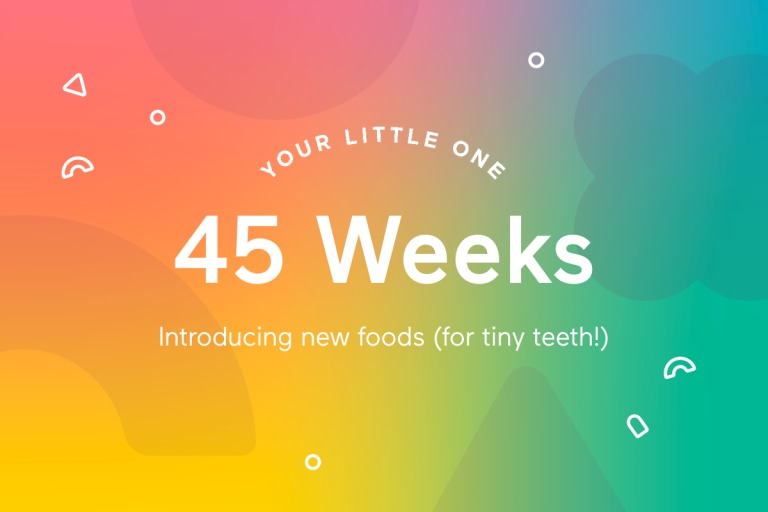
Your 45-Week-Old Baby
Separation anxiety, melasma and motor skills (oh, my!)

By Babylist Staff
What to Know About Separation Anxiety
If your little social butterfly is suddenly experiencing separation anxiety, it can cause major anxiety for you too.
Wasn’t it just last week when your kiddo didn’t really care that you left for work or the supermarket? Now there are tears (so.many.tears), devastating cries and outstretched arms whenever you do so much as look at the front door.
Separation anxiety is a developmental milestone that can occur around 6-7 months and peak right about now. Babies understand that even when they don’t see you…you’re still there (somewhere!). And when they can’t see you when they want to, they don’t like it. Separation anxiety can kick in with a babysitter or even when they’re in their crib at bedtime.
First and foremost, know that separation anxiety is normal and actually a good thing! Although you might feel like crying yourself after those dramatic goodbyes, it’s a temporary phase that is fostering independence. In the meantime, there are some simple things you can do to ease separation anxiety:
- Babysitters: If you have a new babysitter, give your baby a chance to adjust to that person before you leave. Invite the babysitter over for a short visit to meet your baby while you’re hanging out at home. And try to stick around for a bit prior to making those initial exits so your baby can get comfortable and hopefully distracted. Ideally, when you give them a kiss as you jet out, they may be too engrossed in those cool blocks to go into sob mode.
- Make it quick: Don’t sneak out or do a long, drawn out goodbye. Bid farewell in an upbeat, brief and matter-of-fact way so your baby understands you are leaving and can tell from your cheery face that the world is actually not ending. And no matter what, don’t pop back in to check on how they’re doing! You’ll get a text or call if the sitter needs you.
- ‘Separate’ at home: As long as your baby is in a safe space, it’s fine to walk into another room for a few minutes so your baby is OK with not being in arm’s reach 24/7.
Whether it’s a daycare drop-off or leaving your child at home with a caregiver, be consistent in your goodbye routine. And rest assured that the waterworks will be short-lived. They’ll probably stop crying just a few seconds after you leave.
Still Seeing the ‘Mask of Pregnancy’?
Melasma, aka “the mask of pregnancy,” causes dark brownish patches of discoloration on the face (thanks, hormones!). Although it can affect anyone, this form of hyperpigmentation is more common in pregnant women. Melasma typically goes away on it’s own as your hormones go back to normal after you give birth. But it can be exacerbated by the sun. So if some light splotches are still lingering, be sure to avoid direct exposure to the sun as much as you can, and use sunscreen with an SPF of 30 or higher daily (even when it’s cloudy!). If you’re still feeling self-conscious, go to your dermatologist to discuss topical treatment options.
And speaking of sunscreen…your baby needs a tube, too. We’ll save you from a night of Googling—these are Babylists top picks for sunscreens for baby. They check all the boxes: broad-spectrum coverage, natural ingredients, water resistant, have an SPF of at least 15 and they’re easy to apply. PS: did you know a sunburn can happen in just 10 minutes?
The Benefits of Repetition in Play
Your baby probably loves doing the same activity over and over (and over) again. Little ones at this age really enjoy (and learn from) repetitive tasks. Not only does repetition help them master new skills, but it builds confidence and brings a comforting sense of predictability. A toy like this Ball Popper can sets the scene for endless popping, dropping and rolling while boosting fine motor skills.
Time for Textured Foods
Your baby probably is ready for food with a more texture. Now that they likely have a few teeth, you can change things up with their favorite foods. Instead of super-smooth purees or your go-to finger foods, try adding new textures to mealtime. Make your purees thicker and chunkier. You can also simply mash up soft veggies, lentils and beans. Offer foods like cottage cheese, yogurt and hummus. The more your baby gets used to foods with different textures, the more willing they’ll be to try—and like—new things!